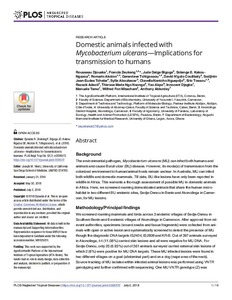| dc.contributor.author | Djouaka, R. |
| dc.contributor.author | Zeukeng, F. |
| dc.contributor.author | Bigoga, J.D. |
| dc.contributor.author | Kakou-Ngazoa, S.E. |
| dc.contributor.author | Akoton, R. |
| dc.contributor.author | Tchigossou, G. |
| dc.contributor.author | Coulibaly, D.N. |
| dc.contributor.author | Tchebe, S.J.E. |
| dc.contributor.author | Aboubacar, S. |
| dc.contributor.author | Nguepdjo, C.N. |
| dc.contributor.author | Tossou, E. |
| dc.contributor.author | Adeoti, R. |
| dc.contributor.author | Ngonga, T.M.N. |
| dc.contributor.author | Akpo, Y. |
| dc.contributor.author | Djegbe, I. |
| dc.contributor.author | Tamo, M. |
| dc.contributor.author | Mbacham, W.F. |
| dc.contributor.author | Ablordey, A. |
| dc.date.accessioned | 2019-12-04T11:27:30Z |
| dc.date.available | 2019-12-04T11:27:30Z |
| dc.date.issued | 2018-07 |
| dc.identifier.citation | Djouaka, R., Zeukeng, F., Bigoga, J.D., Kakou-Ngazoa, S.E., Akoton, R., Tchigossou, G., ... & Ablordey, A. (2018). Domestic animals infected with Mycobacterium ulcerans—Implications for transmission to humans. PLoS Neglected Tropical Diseases, 12(7), e0006572. |
| dc.identifier.issn | 1935-2735 |
| dc.identifier.uri | https://hdl.handle.net/20.500.12478/4951 |
| dc.description | Open Access Journal; Published online: 2 July 2018 |
| dc.description.abstract | Background
The environmental pathogen, Mycobacterium ulcerans (MU) can infect both humans and animals and cause Buruli ulcer (BU) disease. However, its mode(s) of transmission from the colonized environment to human/animal hosts remain unclear. In Australia, MU can infect both wildlife and domestic mammals. Till date, BU-like lesions have only been reported in wildlife in Africa. This warrants a thorough assessment of possible MU in domestic animals in Africa. Here, we screened roaming domesticated animals that share the human microhabitat in two different BU endemic sites, Sedje-Denou in Benin and Akonolinga in Cameroon, for MU lesions.
Methodology/Principal findings
We screened roaming mammals and birds across 3 endemic villages of Sedje-Denou in Southern Benin and 6 endemic villages of Akonolinga in Cameroon. After approval from relevant authorities, specimens (wound swabs and tissue fragments) were collected from animals with open or active lesion and systematically screened to detect the presence of MU though the diagnostic DNA targets IS2404, IS2606 and KR-B. Out of 397 animals surveyed in Akonolinga, 44 (11.08%) carried skin lesions and all were negative for MU DNA. For Sedje-Denou, only 25 (6.93%) out of 361 animals surveyed carried external skin lesions of which 2 (8%) were positive for MU DNA targets. These MU infected lesions were found in two different villages on a goat (abdominal part) and on a dog (nape area of the neck). Source-tracking of MU isolates within infected animal lesions was performed using VNTR genotyping and further confirmed with sequencing. One MU VNTR genotype (Z) was successfully typed from the goat lesion. The evolutionary history inferred from sequenced data revealed a clustering of animal MU isolates within isolates from human lesions.
Conclusion/Significance
This study describes the first report of two MU infected lesions in domestic animals in Africa. Their DNA sequence analyses show close relationship to isolates from human cases. It suggests that MU infection should be suspected in domestic hosts and these could play a role in transmission. The findings further support the hypothesis that MU is a ubiquitous environmental pathogen found in endemic areas, and probably involved in a multiple transmission pathway. |
| dc.description.sponsorship | AgroEcoHealth Platform |
| dc.format.extent | 1-19 |
| dc.language.iso | en |
| dc.rights | CC-BY-4.0 |
| dc.subject | Mycobacterium |
| dc.subject | Transmissions |
| dc.subject | Humans |
| dc.subject | Animals |
| dc.subject | Diseases |
| dc.subject | Pathogens |
| dc.title | Domestic animals infected with Mycobacterium ulcerans - implications for transmission to humans |
| dc.type | Journal Article |
| dc.description.version | Peer Review |
| cg.contributor.affiliation | International Institute of Tropical Agriculture |
| cg.contributor.affiliation | University of Yaoundé |
| cg.contributor.affiliation | Pasteur Institute Abidjan |
| cg.contributor.affiliation | University of Abomey-Calavi |
| cg.contributor.affiliation | Akonolinga District Hospital, Cameroon |
| cg.contributor.affiliation | University of Parakou |
| cg.contributor.affiliation | University of Ghana |
| cg.coverage.region | Africa |
| cg.coverage.region | West And Central Africa |
| cg.coverage.country | Benin |
| cg.coverage.country | Cameroon |
| cg.creator.identifier | Rousseau Djouaka: 0000-0003-4772-0753 |
| cg.creator.identifier | Manuele Tamò: 0000-0002-5863-7421 |
| cg.researchtheme | NUTRITION & HUMAN HEALTH |
| cg.researchtheme | PLANT PRODUCTION & HEALTH |
| cg.isijournal | ISI Journal |
| cg.authorship.types | CGIAR and developing country institute |
| cg.iitasubject | Disease Control |
| cg.iitasubject | Nutrition |
| cg.iitasubject | Plant Health |
| cg.iitasubject | Plant Production |
| cg.journal | PLOS Neglected Tropical Diseases |
| cg.howpublished | Formally Published |
| cg.accessibilitystatus | Open Access |
| local.dspaceid | 102049 |
| cg.targetaudience | Scientists |
| cg.identifier.doi | https://dx.doi.org/10.1371/journal.pntd.0006572 |

